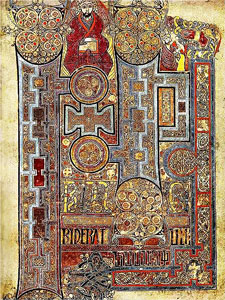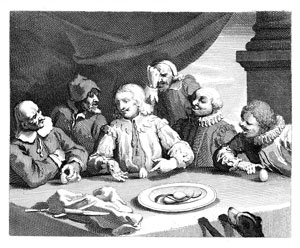TRINITY

Gospel of John
Book of Kells
Actually, John refers to Jesus, the Son of God, as that That was the true Light, which lighteth every man that cometh into the world. However, according to a meeting in the town of Niceae back in 325 AD, all Christians now believe that the Father and the Son are one and the same. However, not everyone in those days agreed with the results of this meeting. There were at least four schisms that battled it out:
| This Group | Believed Father and Son were... | ||
| 1. | Homoousians | identical | |
| 2. | Homoians | similar | |
| 3. | Homoiousians | alike | |
| 4. | Heteroousians | different |
In the end, there was a big war, and the homoousians defeated all the other homos with an i following an o in their names. The heteros never had much of a chance either. So this is why in today's Christianity, attributes that apply to the Father must apply to the Son, and vice versa. Therefore, if Jesus is light, then His Father must be also. This means that each, which are really the same, is capable of zipping around the universe in the twinkle of an eye.
We may counter argue that this is but mere metaphor: these divine entities are only similar to light waves in that they enlighten our divinity within. But no...If we do this, we arbitrarily pick what is metaphorical from a collection of books we have declared as totally factual. Can we tolerate the contradiction? Sure we can. Humans are very good at living with contradictions. We could just as easily say that Genesis is a metaphorical myth, and not factual. Who decides? Do we submit to another's decision, or do we choose freely? What exactly creates a universe, anyway? Where did the ideas of creation and universe come from?
This confusion between fact and metaphor would never have been a problem a thousand years ago. In those days, there was no difference between fact and metaphor. But something called science occurred somewhere between then and now. Nowadays, we all want to legitimize our beliefs by jumping on the science wagon. Without scientific validation are our lives meaningless? It's enough to make us long for a Second Life before our Next Life begins.
Many years after Niceae, Jonathan Swift chronicled a war between those who cracked their eggs on the little end, and those who believed in the big end. In the late 20th century, this war rekindled between architects of Mac and those of Win. No one today remembers who fought for the little endians, nor those who fought for the big. In the end, does it matter one iota?

“Homoousian is unintelligible.”
—Isaac Newton